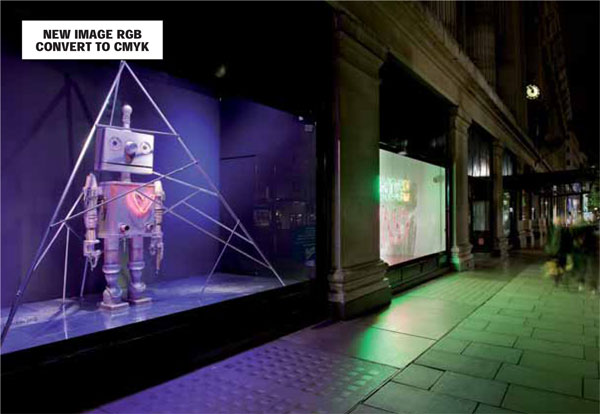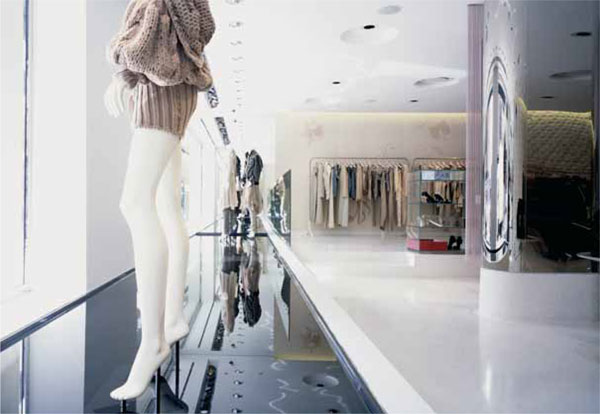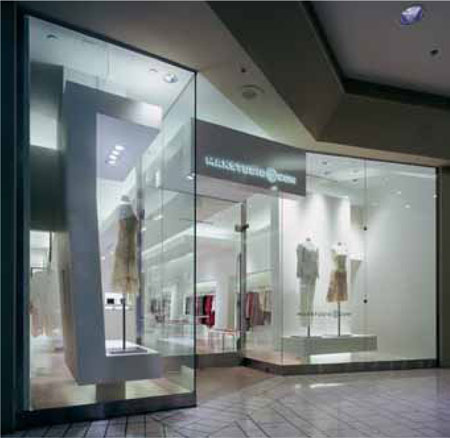Getting to know your windows
Before attempting to design and dress a window, it is best to understand the space and depth of the window you might be expected to work with, as well as the practical features that will affect what you can put into the window and how.
Window size and style
The scale of the window you have to work with may affect what you can achieve. There is no standard size or shape of window in major shopping streets; every store window will differ. Larger windows will require a lot more merchandise and more props to fill them; others may require less. In addition to the scale of the window, there are a variety of styles. The most common are closed or open-back windows and shadow boxes. Thought also needs to be given to shops with no window at all.
Closed windows
These are usually seen in department stores. With a large pane of glass at the front (facing the audience in the street), a solid back wall and two solid side walls, and a door, these windows resemble a room. They are the most thrilling to dress because you can capture the public’s attention from just one angle: the street.
Closed windows need considerable planning before they are dressed. Usually large, they will require a lot of merchandise to fill them. Props will also have to be big, and possibly made in multiples, thus adding to the cost. However, expensive merchandise can be used, providing that the door is secure and customers will not be able to gain access and tamper with the presentation. From a design point of view, because they are seen from only one angle, the dressing needs only to be front-facing.
Open-back windows
These have no back wall but may have side walls. Many retailers prefer them because they make the interior of the shop visible from the outside. This does mean, however, that the interior will need to be maintained and look attractive at all times. These windows can be more difficult to dress because they are viewed from both outside and inside. Unlike in the closed window, expensive merchandise would not be secure, so it is not suitable for use in this type of window. Thought also needs to be given to the possibility that customers may be able to touch the display.
No window
Shopping arcades often have good examples of stores with no windows. The whole front of the store is exposed to the public with only a grille to separate the store from the public in the evening. Because there is no door or partition stopping customers from entering, these stores encourage the public to walk inside and browse. There may seem to be no window-display requirement; however, display bases can be positioned just inside the entrance with presentations dressed to attract the customers.

A closed window can be treated like a stage, as shown here at Selfridges, London, where the window scheme faces the audience—the passing shopper on the street.

Like a closed window, open-back windows should be dressed toward the customer in the street, but because they give a view into the store, both the window and the store sides need to be well maintained. This example shows Stella McCartney, New York.

The entrance to a store with arcade windows is farther away from the street; the role of window dressing here is to draw the customer along the window and into the store, as is the case with Max Studio, Los Angeles.

A corner window will attract attention from two angles. It is therefore important to ensure that both windows are eye-catching—as are these in Bershka, San Sebastian, Spain.

Positioned at eye level, the shadow box is the perfect place in which to present smaller, more precious items, as demonstrated at Cartier in Selfridges, London.
Angled windows
These are angled back to the entry. This type of window is gradually being replaced on major shopping streets, but if you are faced with such a window, remember that groupings and products should be displayed parallel to the pane of glass—not to the sidewalk. This is because customers are more likely to stop and stand in front of the pane of glass on their way to the door. Dressing a window like this gives you the advantage of being able to work with the whole surface area of the glass.
Corner windows
Here, the windows wrap around a corner. In these windows groupings should be dressed toward the center of the arc. Clever use of groupings can help lead the customer from one side of the window all the way around to the other and on toward the entrance of the store.
Arcade windows
Here, the door is set back from the windows. In this case, part of the display should be facing the sidewalk to gain the customer’s attention, and another part of it should be set for display on the return, leading the customer toward the door.
Shadow boxes
Stores that specialize in small items such as jewelry often rely on shadow boxes to attract the customer’s attention. These miniature windows are placed at eye level to allow close scrutiny of the merchandise.

Three sporty mannequins run and jump through the Nike window in Beijing, China. Their dramatic poses enforce the brand’s concept. Using only red merchandise reflects the Nike logo.
Window setup
Before designing a window, the visual merchandiser needs to understand what is available to work with. Ideally, an experienced visual merchandiser would like a blank canvas to work on that has certain features.
Solid wooden walls
A closed window will always benefit from having strong, solid walls. The back wall forms a backdrop to the window display. Together with the side walls, it should have an even surface that can be painted or covered to co-ordinate with the window scheme. All the walls should be strong enough to take nails or screws.
Floor panels
MDF removable floor panels are easy to take out and cover, either with fabrics or PVC. They can also hold nails and screws. Being able to alter the flooring in a window can dramatically change the whole appearance of the presentation. Some smaller retailers prefer a fixed floor that is painted every time the scheme changes, while others may prefer a solid, fixed wooden or stone floor that is not altered each time the window is dressed. Both are acceptable but need to be taken into consideration when planning the window scheme. A solid stone floor will not be suitable for setting up a mannequin because it may not be possible to hammer a nail into such a dense surface (see page 195).
Ceiling grid
A sturdy metal grid painted the same color as the ceiling so that it blends in is of the utmost importance in any window; you may want to hang banners, props, or even mannequins from it at some point. In the longer term, it will mean that holes don’t have to be made in the walls for screws and bolts, necessitating repair work before the next dressing.
Secure door
In a closed window, a concealed door will not only enable you to enter and exit the window, it will also secure any expensive products. Ideally a door in a closed window is best positioned in a side wall rather than in the back wall, where it would dominate the window display and would be in full view of the customers. A good-quality locking device is also recommended.
If you are working on a particularly tall window, mannequins can be elevated on plinths to help fill the larger space.

Painted the same color as the ceiling, the lighting grid can be used to hold the lighting tracks, as well as props and products as shown here.
Lighting tracks
Many of the greatest windows are made even more eye-catching by the clever use of lighting. This is only possible if the window is equipped with high-quality lighting fixtures. We will explore lighting requirements later in the book (see page 92).
Electric sockets
It is advantageous to have a few sockets in any window. They should be hidden either side of the window next to the glass. As with the door, customers should not be able to spot the sockets on the back wall. It is also wise to install a couple in the ceiling close to the glass and out of sight.
Window shade
Many visual merchandisers prefer to create their masterpieces while hidden from the public. A window shade also hides the mess caused while either dressing or stripping a window.
Easy access
Moving larger props or furniture items into a window will be much easier if the door is wide enough. The visual merchandiser also needs access to be able to maneuver items through the department at the back of the window.
Speakers
In many department or large stores, security is paramount. While a visual merchandiser may be locked away dressing a window, it is important that he or she keeps in contact with the outside world via in-store announcements.
Fire sprinklers
Fires have been known to start in a window because of faulty wiring or an overheated light fixture. A fully operational sprinkler system will help prevent such accidents.

With all the correct components for a window in place, the display will be ready for installation.
